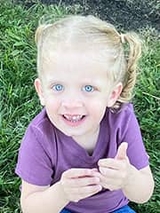Neurofibromatosis 1: Carlee’s Story
Neurofibromatosis 1: Carlee’s Story
Four-year-old Carlee has had many obstacles to contend with in her short life: She was diagnosed with neurofibromatosis 1 (NF1), and the disease caused tumors to develop in her head, one of which resulted in vision loss. She has autism and is nonverbal. At Children's Hospital of Philadelphia (CHOP), she sees multiple specialists and receives learning and behavior support. “As challenging as it has been,” says her mother, Amy, “CHOP has made it so much easier.”

Carlee was adopted by Amy and her husband, Chris, when she was a baby. “Her birth father has NF1, so we knew there was a possibility she’d have it,” says Amy. From birth, Carlee had a larger-than-average head size, trouble gaining weight, and the café au lait spots that can signal NF1. When she was a little older than 1, she began exhibiting developmental delays, and then Amy and Chris noticed an issue with Carlee’s eyes: She didn’t seem to be focusing and her eyes seemed to be bulging.
They took her to an ophthalmologist, who said Carlee’s optic nerves were swollen and that she should be seen at CHOP as soon as possible. They got an appointment the next day with Robert Avery, DO, MSCE, a pediatric neuro-ophthalmologist in CHOP’s Division of Pediatric Ophthalmology. Carlee was diagnosed with NF1, a genetic disorder that affects all body systems and is associated with an increased risk of cancer as well as low-grade tumors of the nervous system, including tumors that form along the optic pathway and tumors of the peripheral nerves. An MRI revealed tumors along both of Carlee’s optic nerves.
With Carlee’s vision deteriorating, Dr. Avery and Michael Fisher, MD, Chief of the Section of Neuro-Oncology and Director of the Neurofibromatosis Program, thought it was best to start chemotherapy right away. Carlee received intravenous chemotherapy for a year and a half.
Treating the whole child
More About NF1
As part of the NF Program’s comprehensive care, patients are screened for motor skills, language skills and social-emotional development. If any concerns or delays are identified, the CHOP team makes recommendations about how the family can support the child’s development — for example, a referral for additional evaluation at CHOP, early intervention programs and school services. After completing the screening questionnaire, Carlee’s family received a home assessment for safety concerns, got recommendations for in-school support, and received resources to access applied behavior analysis therapy for Carlee’s autism.
“We’ve gotten so much through CHOP — we’ve gotten whatever we needed as far as therapies,” says Amy. “It has helped Carlee so much. She’s making a lot of progress. Her frustration level has decreased, so she’s not lashing out as much.”

Medically, Carlee made it through most of the IV chemotherapy treatment schedule, but at times her platelet levels would drop, and the medications had to be put on hold. In addition, a tumor developed in her right ear and kept growing. Drs. Avery and Fisher recommended switching to oral chemotherapy to manage the tumor in the ear and to complete treatment for the optic pathway tumors. “The tumor in her ear shrank drastically,” says Amy. “It was just amazing.”
Amy is thrilled with Carlee’s progress in many areas. “She knows her numbers 1 through 10, she can pick out a letter from the alphabet, and she’s making an effort to talk,” Amy reports. “And her vision is improving! When her vision was getting checked, she never used to let us cover the right eye, so we didn’t think she could see at all out of her left eye. Since starting the oral chemo, she saw three vision cards with her left eye!”
Amy is grateful for everyone at CHOP who has contributed to Carlee’s care:
“We couldn’t ask for a better team. They’re phenomenal.”